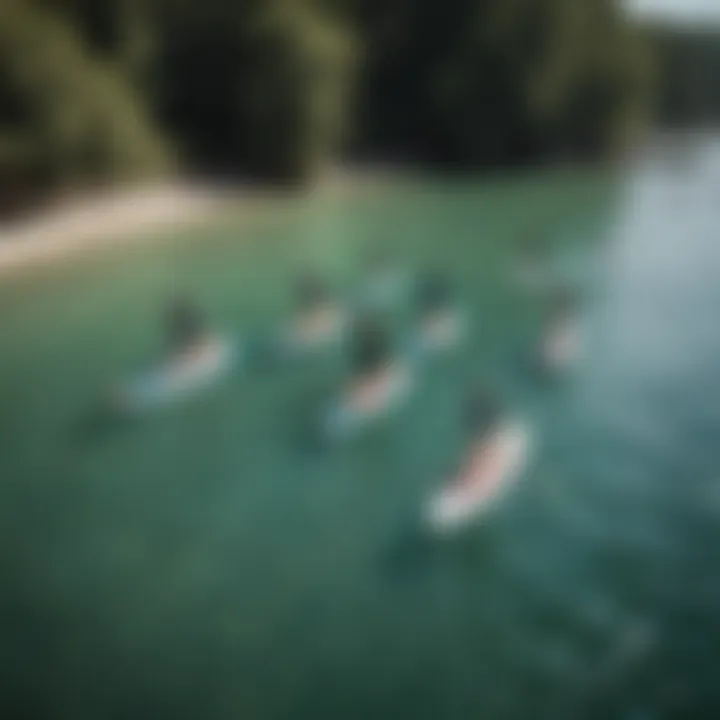Exploring Wide Stand Up Paddle Boards: A Guide


Intro
Wide stand up paddle boards (SUPs) have gained significant traction in the watersports community. Often seen gliding along serene lakes or battling ocean waves, these boards offer a unique blend of stability and versatility. With their increased width, they provide a solid platform for paddlers of all skill levels. As the saying goes, "the more the merrier!" – which definitely rings true when talking about space on these boards.
One of the key factors that make wide SUPs appealing is their capacity to handle various conditions. Whether you're venturing out for a leisurely paddle on calm waters or testing your paddling prowess against the rolling surf, a wider board can elevate your experience. This guide delves into the specific aspects of wide stand up paddle boards—from their design and performance to practical tips for selecting and maintaining them.
Gear Recommendations
Essential Gear for Beginners
If you’re just starting out, it’s important to equip yourself with the right gear. You wouldn’t attempt to bake without an oven, right? Here's a list of essential items:
- Wide Stand Up Paddle Board: Focus on stability. Look for a board that's between 30-36 inches wide.
- Paddle: Opt for an adjustable paddle made from lightweight materials. Carbon fiber paddles are excellent, but a sturdy aluminum one can also do its job well.
- PFD (Personal Flotation Device): Always have a life jacket on board. Even the best swimmers can find themselves in unexpected situations.
- Leash: A coiled leash keeps your board tethered to you. This safety measure prevents your board from drifting away during a fall.
- Wet Suit: Depending on your climate, a wetsuit can offer comfort and warmth, shouldn't you end up in the drink.
Advanced Equipment for Professionals
For those who have honed their paddling skills, specializing your setup can make a difference. Consider diving into this gear:
- Performance SUPs: Look for boards designed for speed and agility, often longer and narrower than beginner models.
- GPS Watch: Track your distance, speed, and routes for more detailed performance analysis.
- Action Camera: Capture those epic moments on the water, be it a spectacular sunset or a rogue wave.
- Repair Kit: Always a good idea to carry a small kit for quick fixes just in case you face an unexpected puncture or scrape.
"Choosing the right gear is just as important as honing your skills—don’t overlook it!"
Techniques and Tips
Skill Improvement Strategies
To truly maximize your experience on a wide stand up paddle board, improving your technique is key. Consider these strategies:
- Practice Balance: Spend time simply standing on your board to get a feel for it. You might look a bit silly at first, but practice makes perfect.
- Paddle Technique: Focus on your stroke. Engage your core and keep your arms extended while pulling the paddle through the water. This will enhance efficiency and allow for longer paddles without fatigue.
- Posture: Keep your knees slightly bent and your back straight. This positioning allows for better balance and control.
- Vary Your Strokes: Experiment with different techniques, like forward strokes, sweeping strokes for turning, or back paddling to slow down or reverse.
Safety Practices and Guidelines
No adventure should come at the cost of safety. Follow these guidelines to stay safe while paddling:
- Check Weather Conditions: Always have an eye on the forecast. Sudden changes can impact your paddling experience.
- Stay Hydrated: Bring water along to keep yourself refreshed; sun and exertion can sneak up on you.
- Paddle with Friends: It’s good practice to stick with a buddy or group, especially for longer outings.
- Know Your Limits: Push yourself to improve, but don’t bite off more than you can chew. Listen to your body and heed any warning signs.
The world of wide stand up paddle boards offers a treasure trove of experiences and opportunities for exploration. With the right gear and practices, anyone can find joy on the water. It's not just about paddling; it's about crafting unforgettable stories while gliding over the liquid highway.
Prolusion to Stand Up Paddleboarding
Stand Up Paddleboarding (SUP) has become increasingly popular over the last decade, drawing in sports lovers, casual participants, and everyone in between. This introduction serves as a foundation to comprehend the nuances of not just paddleboarding in general but particularly the context around wide stand up paddle boards. By understanding the mechanics and benefits of SUP, readers can appreciate why these wider boards are becoming go-to choices for both amateurs and seasoned paddlers alike.
Understanding Stand Up Paddleboarding
Stand Up Paddleboarding, at its core, combines elements of surfing and kayaking, creating a significantly versatile water sport. The paddleboarder, standing upright on a floating board, uses a paddle to navigate through various water conditions. It's an accessible sport that doesn’t require excessive skill or prior experience, making it inviting for newbies.
The basic premise involves a paddle and a board, but there’s much more beneath the surface. Proper technique, balance, and body positioning can lead to a rewarding experience. The sense of freedom one feels gliding across a lake or the ocean is profound. Many paddleboard enthusiasts report feeling a unique connection to nature while practicing SUP, which brings about mental clarity and physical exercise.
The Popularity Surge of Paddleboarding
Paddleboarding has seen a meteoric rise in popularity, with reports showing a staggering growth in participation over the years. Factors contributing to this increase include:
- Accessibility: The simplicity of the gear and low barrier to entry attracts a wide demographic.
- Health Benefits: SUP provides a fantastic full-body workout. Users improve their cardiovascular health, get stronger core muscles, and build endurance.
- Community and Culture: Paddleboarding has cultivated a vibrant community, from social media groups to local meetups. Enthusiasts share tips, experiences, and even host events, making it a social sport.
- Variety of Environments: Whether on lakes, rivers, or oceans, paddleboarding offers diverse beautiful settings, appealing to adventurous spirits.
"Stand up paddleboarding is more than a sport; it’s a lifestyle embraced by many who find joy in the simplicity of gliding across water."
With such momentum, wide stand up paddle boards are increasingly favored, especially for those valuing stability and ease, setting the stage for what’s to come in this comprehensive guide.
Defining Wide Stand Up Paddle Boards
Defining wide stand up paddle boards is an essential part of understanding the paddleboarding experience. These boards are not just wider versions of their narrower counterparts; they offer unique features and benefits that cater to a variety of paddlers. Recognizing what makes a board wide, often above thirty inches, can help enthusiasts choose the right gear for their needs. This section dives into the specific characteristics that set these boards apart and compares them to standard models, aiming to equip readers with the necessary knowledge for an informed purchase.
Characteristics of Wide Paddle Boards
Wide paddle boards are designed with several key characteristics that enhance their usability on the water. One of the most notable features is their increased width. This added width contributes to better stability, making it easier for beginners and those who may struggle with balance to stay upright while paddling.
Another characteristic is the board's buoyancy. The wider the board, the more surface area it has, which translates to greater lift in the water. This buoyancy allows paddlers to ride over waves and choppy waters more smoothly.
- Material Choices: Many wide boards are made from foam or inflatable materials, offering varying flexibilities. Foam boards tend to be more rigid, providing a solid feel, while inflatable boards can be more forgiving and easier to transport.
- Length Variability: Wide boards often come in different lengths, enabling users to select one that matches their paddling style. Longer boards can cover more distance efficiently, while shorter ones are easier to maneuver.
- Deck Pad Features: A wider deck usually allows for a larger grip area. Many boards feature textured pads, enhancing traction for the paddler's feet.
These characteristics make wide paddle boards particularly popular among families and recreational paddlers who appreciate a stable and forgiving platform for navigating various water conditions.
Comparison with Standard Boards
When you stack wide stand up paddle boards against standard models, the differences become quite clear.
- Stability vs. Speed: Wider boards offer much greater stability, which is beneficial for beginners. Standard boards, however, tend to be sleeker and faster, making them ideal for competitive paddlers or those looking to cover long distances quickly.
- Purpose of Use: For casual fun, family outings, or yoga, wide boards take the cake with their balance. Standard boards shine in racing or performance-focused scenarios where speed is crucial.
- Load Capacity: Wider boards can handle bigger payloads. They are excellent for carrying additional equipment or even passengers, while standard boards typically have lower load capacities due to their narrower width.
"Wide boards provide an incredible sense of stability, making them perfect for learners and those who enjoy a leisurely paddle on the lake."


Overall, the choice between a wide paddle board and a standard one boils down to the user's priorities. Stability and comfort often trump speed and agility in various scenarios. Whether taking the family out for a fun day on the water or searching for a board for fitness activities, understanding the defining characteristics of wide stand up paddle boards helps paddlers make informed decisions.
Advantages of Wide Stand Up Paddle Boards
Wide stand up paddle boards have gained traction among paddlers for various compelling reasons. As we dig into this topic, it becomes clear that their design features bring unique advantages to those who decide to embrace wider boards. This section covers key benefits like stability, increased load capacity, and an all-around better paddling experience, shedding light on why these boards are often favored in varying aquatic environments.
Stability and Balance
One of the standout benefits of wide stand up paddle boards is enhanced stability. The increased width provides a larger surface area, allowing for better balance while navigating on the water. Imagine standing on a plank versus a picnic table; the difference in stability is palpable. This property is especially advantageous for novices who may still be finding their sea legs.
Not only does improved stability help beginners develop their confidence, but it also benefits experienced paddlers when conditions get choppy. A wider board means reduced chances of tipping over, helping you navigate rougher waters with ease. This stability also allows for a smoother ride, making paddling less laborious and more enjoyable, especially during longer excursions on the water.
Increased Load Capacity
Wide paddle boards often boast higher weight limits, accommodating more gear or even additional passengers. This attribute is a game-changer for group outings or day trips where food, beverages, and extra gear are necessities. For instance, you could easily pack along a cooler for a picnic or a kayak with friends, making your time on the water more diverse.
When considering load capacity, it’s essential to weigh the board's construction and design. Wider boards distribute weight more evenly, preventing them from becoming overwhelmed regardless of the load.
Enhanced Paddling Experience
With their ample surface area, wide stand up paddle boards offer a more enjoyable paddling experience overall. The improved buoyancy means they float better, allowing for smoother gliding through water. Additionally, the broader stance encourages a comfortable, relaxed paddling position, which is especially beneficial when embarking on long journeys.
When it comes to versatility, you can experiment with different paddling techniques—be it yoga, fishing, or leisurely rides with family. You’ll find that a wide board is accommodating and equipped to handle various activities.
"Wide stand up paddle boards open up diverse water experiences while boosting both comfort and fun."
Selecting the Right Wide Paddle Board
Choosing the right wide paddle board is one of the most critical decisions you will make as a paddler. It can dramatically influence not just your enjoyment but also your performance on the water. A wide paddle board can offer extra space and stability, making it easier for beginners to learn the ropes and for seasoned paddlers to tackle challenging conditions.
However, it’s not all about picking the widest board you can find. Understanding various key factors, from board dimensions to material construction and weight distribution, can shape your ideal experience on the water. Here’s what you should consider.
Factors to Consider
Board Dimensions
Board dimensions play a pivotal role in how a paddle board behaves in the water. The width of the board directly impacts stability. A wider board, such as those exceeding 30 inches, provides considerable stability, useful for activities like fishing or yoga. This feature is especially helpful for paddlers who are still getting their sea legs.
Something unique about board dimensions is the balance between width and length. While a wider board feels stable, it might also create drag in the water, affecting your paddling efficiency. Therefore, finding the right balance is essential to enjoy the sport while avoiding unnecessary effort.
Material and Construction
Material and construction are equally important as they dictate a board's durability and performance. Common materials include epoxy and polyethylene. For instance, epoxy boards are known for being lightweight and stiff, translating to better speed and responsiveness. On the flip side, polyethylene boards are typically more robust, making them a good choice for more rugged environments.
What’s interesting here is the trade-off; while epoxy boards may handle well, they could be prone to scratches and dings. In contrast, the sturdiness of polyethylene may result in a bit of extra weight, which can affect portability. Ultimately, selecting your board's material hinges on your priorities: performance or durability.
Weight Distribution
Weight distribution is often a forgettable but vital aspect when looking at paddle boards. It can significantly impact how manageable your board feels during paddling. Properly weighted boards ensure that the paddler's weight is evenly distributed, which makes for a smoother ride. You’ll also find that boards designed with optimal weight distribution can allow you to carry additional gear without sacrificing balance.
The key to weight distribution lies in understanding intended usage. If planning on carrying extra gear for long paddles, a board designed with this in mind will help avoid tipping. Conversely, if your focus is agility, choosing a narrower board with more centralized weight could be advantageous.
Evaluating Your Needs
Purpose of Use
When considering your purpose for using a wide paddle board, reflect on the activities you plan to engage in. Whether it’s leisurely paddling on calm lakes or tackling ocean waves, the intended use should guide your choice. Each activity demands different specifications, from board length to rocker and shape. Knowing your focus beforehand can narrow down options and elevate your experience on the water.
A unique aspect to consider here is that many boards are marketed toward specific purposes, but some boards serve multiple roles. For example, a board designed for flat water can also work well for light surfing. Evaluating your needs ensures you select a board that adapts to your evolving interests.
Skill Level
Your skill level is instrumental when selecting a wide paddle board. Beginners will benefit from wider boards that offer stability, while more advanced users may prefer a narrower profile that allows for easier maneuverability. A skilled paddler may thrive on a board that cuts through water with finesse, while a novice paddler might wobble in a narrower board, causing a frustrating experience.
Something interesting about skill level is that it can evolve quickly. What suits you now may not hold in a year or two. Hence understanding the flexibility of your choice while factoring in previous board experiences can provide insights into what features to prioritize.
Budget Constraints
Lastly, budget constraints will heavily influence your selection. Wide paddle boards come with a varied price range, so it’s crucial to identify your budget before starting to shop. While you might be tempted to go for the high-end models promising advanced technologies and materials, many mid-range options exist that perform admirably for recreational paddle boarding.
A unique facet here is that investing in a quality board can often save money in the long run. A well-built board can last for years, reducing the need for replacements. Therefore, while the upfront cost might put a dent in your wallet, consider the value it offers your paddling experience over time.
"Selecting the right paddleboard isn’t merely shopping; it’s about aligning your needs with the world's watery playground, ensuring a fulfilling adventure each time you paddle out."
Techniques for Efficient Paddling
Paddling is the core activity of stand up paddleboarding, and mastering various techniques can significantly enhance your experience on the water. Efficient paddling means not just moving forward, but doing so with grace and control, whether you're navigating calm lakes or battling waves. This section delves into the essential techniques, offering guidance on paddle strokes and body positioning that can make all the difference.
Paddle Strokes
Understanding paddle strokes is vital for optimizing your performance. Each type of stroke serves a unique purpose and can be applied strategically as you navigate different situations on the water.


Forward Stroke
The forward stroke is the most prominent paddling technique and the primary way to propel your board. Its key characteristic lies in the long, sweeping motion that creates thrust with each stroke. A clean and powerful forward stroke helps maintain speed and efficiency, essential aspects for longer paddling sessions.
The unique feature of this stroke is that it engages your core muscles, which can lead to better stability and balance on wider boards. Additionally, it helps in minimizing fatigue by allowing your body to work in a more coordinated manner. An advantage of the forward stroke is that it allows for long-distance travel without excessive energy expenditure, making it a beneficial choice for anyone looking to explore vast waterways.
Reverse Stroke
Conversely, the reverse stroke allows a paddler to slow down or maneuver the board in tight spots. It is executed by placing the paddle blade behind the feet and pulling towards the board. This technique is particularly useful for those wanting to control their speed, a crucial skill when approaching dock areas or in small channels.
The key characteristic of the reverse stroke is its ability to provide stability during deceleration. This makes it a popular choice for beginners who are still getting a feel for their board. However, it can be somewhat less intuitive for seasoned paddlers, as it requires a shift in mental processing—moving backward can feel counterproductive at first, but with practice, it becomes a valuable tool.
Turning Techniques
Turning techniques are essential for effective navigation, especially in dynamic environments. Whether you're making a sharp turn to avoid obstacles or simply wanting to change direction with grace, mastering these techniques can enhance your paddling experience.
The most common method involves using a combination of paddle strokes, such as the sweep stroke, where the paddle is taken out wider and back in an arcing motion on one side, while leaning slightly towards that direction to assist in the turn. This technique is beneficial because it maintains speed while adjusting your trajectory.
Additionally, understanding the pivot turn, which involves shifting your weight and using the paddle to ‘scoop’ water while leaning back, is crucial for tight turns in compact settings. Each of these turning techniques supports a paddler’s control over their direction, making them an indispensable choice in a variety of situations.
Body Positioning
Proper body positioning is another cornerstone of efficient paddling. It affects balance, stability, and overall comfort while navigating different waterscapes. The concept is simple yet often overlooked by those starting out; the right stance can drastically alter your experience.
When paddling on wide boards, keeping your feet shoulder-width apart with a slight bend in the knees is recommended. This posture allows for a lower center of gravity, which improves stability, especially in choppy waters. Engaging your core and maintaining an upright posture ensures that each stroke is powerful without causing undue strain on other muscle groups.
Remember, every paddler's body may react differently to various techniques, so it’s wise to find what feels most natural and effective for you.
Mastering your paddling techniques can turn a simple day on the water into a remarkable experience, enhancing both your enjoyment and proficiency in the sport.
The Impact of Board Design on Performance
In the world of stand up paddleboarding, the design of the board is more than just a cosmetic choice; it significantly influences performance on the water. The interplay of various design elements like rocker profiles and fin arrangements can dramatically alter how a board behaves in different paddling conditions. Understanding these factors is crucial for paddlers seeking to maximize their experience and efficiency on the water.
A well-designed board can enhance maneuverability, stability, and speed. Furthermore, it helps the paddler adapt to various environments, whether it's gliding over calm lakes or tackling choppy ocean waves.
Rocker Profiles
Rocker profiles refer to the curvature of the board from nose to tail. This design feature profoundly affects a board's performance, particularly in terms of speed and handling. Boards with more pronounced rocker curves, often called "rockered boards," tend to be more maneuverable and are better suited for surf conditions. They allow for quick turns and can ride up and over waves more easily.
Conversely, boards with minimal rocker (flat boards) offer greater speed and efficiency over flat water. They glide more effortlessly, making them a preferred choice for distance paddlers. Here are some characteristics of rocker profiles to consider:
- More Rocker (Surf Boards):
- Less Rocker (Flat Boards):
- Pros: Increased agility, better for waves, easier to pivot.
- Cons: Less speed on flat water, requires more effort to paddle.
- Pros: Better speed on open water, more stable in flat conditions.
- Cons: Harder to maneuver, less effective in waves.
When choosing a board, keep in mind how you intend to use it. A higher rocker may be suitable for adventure-seeking paddlers looking for thrilling surf, while a flatter board could better fit those aiming for long, tranquil cruises.
Fins and Tracking
Fins play a critical role in determining a board’s stability and directional control during paddling. The fin arrangement directly impacts how well the board tracks, meaning how straight it moves through the water without lateral drifting.
There are several fin types and configurations, each affecting performance differently:
- Single Fin:
- Tri-Fin:
- Twin-Fin:
- Commonly found on many paddleboards, it provides good tracking and is versatile for different conditions.
- Best for recreational use and calm waters.
- Offers enhanced stability and maneuverability, making it suitable for surf-style paddling.
- Ideal for those who plan to use the board in both flat and choppy conditions.
- This configuration can improve speed and maneuverability but can compromise tracking slightly.
- Great for paddlers who like a looser feel in the water.
"A well-thought-out fin configuration can make all the difference in how you experience the water. Each paddler must consider their style and environment to find the right fit."
Ultimately, the choice of fins can complement the rocker design, enhancing overall performance. Understanding how rocker profiles blend with fin arrangements allows paddlers to select boards tailored to their precise needs, fundamentally affecting their paddling experience.
Wide Stand Up Paddle Board Maintenance
Maintaining your wide stand up paddle board is as crucial as selecting the perfect one. While the thrill of paddling through serene waters can be addictive, proper maintenance ensures your board remains in top-notch condition, enhancing your overall experience. Think of it like taking care of a car; if you ignore the basic upkeep, you might find yourself stranded in the middle of a beautiful lake, far from shore.
Regular maintenance not only prolongs the life of your paddle board but also ensures safety while paddling. Cracks, dirt build-up, or poorly maintained fins can lead to suboptimal performance and might thwart a carefree day on the waves. So, let's roll up our sleeves and dive into some cleaning and care techniques that can keep your board as good as new.
Cleaning and Care
When it comes to cleaning your wide paddle board, it’s similar to washing a beloved pet—gentle yet effective. Start by rinsing your board with fresh water after every use, especially if you've paddled in saltwater or near brackish areas. Salt and sand can be quite abrasive, causing long-term damage. Use a soft sponge or cloth—nothing too abrasive, as you wouldn’t want to scratch the surface.
Steps for thorough cleaning:


- Rinse everytime: Make it a habit to rinse the board after each outing to prevent grime build-up.
- Use mild soap: If needed, mix a little mild soap with water and gently scrub the surface and rails with a soft sponge.
- Inspect thoroughly: While cleaning, take a moment to examine the board for any damages. Look for cracks, dents, or loose fittings that might have occurred during your adventure.
- Drying it off: After cleaning, pat the board dry with a soft towel to prevent water spots.
Keeping your board clean doesn’t just make it look good; it can also maintain its performance on the water. A clean surface means better grip for your feet, leading to improved balance as you paddle.
Storage Techniques
How you store your wide stand up paddle board can either prolong or shorten its life. Proper storage is akin to protecting a treasured antique; that little extra attention can keep it intact for years. After all, a well-stored board is a happy board.
Best storage practices:
- Keep it cool: Find a shaded area or a climate-controlled space. Extreme temperatures can warp the board. Avoid leaving it in direct sunlight for long periods.
- Use a padded rack: If possible, use a padded rack that evenly distributes weight. This method prevents warping and maintains the board’s shape.
- Avoid stacking: Never toss your paddle board under heavy gear or other boards. It can lead to dents or damage. Instead, position it upright or horizontally on a soft surface.
- Cover it up: When storing for long periods, consider using a board bag or cover to shield it from dust and UV exposure.
Remember: "Proper maintenance and storage of your wide paddle board can make the difference between a fleeting hobby and a lifelong passion."
Taking these maintenance steps seriously can transform your paddleboarding experience. By ensuring your wide stand up paddle board remains well-cared for, you not only preserve its performance but also safeguard your adventures on the water.
Safety Considerations for Paddleboarding
Paddleboarding can be a thrilling experience, but it doesn’t come without its risks. When embarking on any water adventure, safety should be at the forefront. Ignoring safety can lead to dire consequences, from simple accidents to serious injuries. Thus, understanding the critical safety considerations makes for a safer, more enjoyable paddleboarding experience.
Wearing Personal Flotation Devices
Personal flotation devices (PFDs) are a necessity when paddleboarding. Many states mandate their use for specific age groups or conditions. Even if it’s not a legal requirement in your area, wearing a PFD can be a lifesaver. Imagine gliding over smooth waters when suddenly, you lose your balance and plunge into the depths—this could turn from a fun day to a panic-filled struggle. A properly fitted PFD keeps you buoyant, enabling you to stay afloat while regaining your composure.
- Types of PFDs: There are different types of PFDs tailored for water sports.
- Fit and Comfort: Ensure that the PFD fits snugly but not too tight. You should be able to move around without feeling restricted. Look for adjustable straps as they allow for fine-tuning.
- Type III: Most common for paddleboarding, designed for comfort and maneuverability.
- Inflatable: A compact option that provides buoyancy when deployed but can be uncomfortable to wear constantly.
"It’s better to have a PFD and not need it than to need it and not have it."
Assessing Weather Conditions
Weather can turn a delightful paddleboard outing into a precarious situation in the blink of an eye. Factors such as wind speed, precipitation, and temperature can alter both conditions on the water and your safety. It’s vital to have an understanding of how to assess the weather before hopping on your board.
- Check the Forecast: Always check the weather updates specific to your paddling location. Signs like windy conditions or an approaching storm should raise a red flag.
- Wind Speed and Direction: Generally, wind speeds over 15 knots can make paddling quite difficult, especially for beginners. Crosswinds can be particularly challenging, so always note the direction of the wind as well.
- Water Conditions: Look for any changes in water color or surface agitation that might signal approaching storms or changing tides. Standing waves or a sudden drop in temperature could indicate choppy water, and it might be wise to reconsider your plans.
A little preparation and awareness about your surroundings can go a long way in ensuring a safe and enjoyable paddleboarding experience. Navigating attentive to safety not only protects you but also enriches your overall engagement with the water.
Exploring Paddleboarding Destinations
Paddleboarding isn't just about the board; it's about where you set your feet on the water. Choosing the right location can make all the difference in your experience. A well-chosen destination can enhance your skills, offer spectacular views, and provide a connection to nature that few other sports can match. Plus, it becomes more than just a fun outing, as it opens up opportunities to explore diverse ecosystems and engage with contrasting environments.
Finding a destination that suits both your ability level and your paddleboarding style is vital. Whether you are an adventurous spirit seeking challenging waters, or a novice looking for a calm lake, knowing what to expect from your environment will set the tone for your paddleboarding experience. Additionally, selecting a destination with proper amenities, safe launching areas, and local regulations can propel your day into a hassle-free delight.
Top Locations for Paddleboarding
Here are a few standout destinations that cater to various paddling tastes. Each location has attributes that provide unique thrills and challenges:
- Lake Tahoe, California/Nevada
Known for its stunning clear waters, Lake Tahoe offers breathtaking views and an array of paddleboarding options. From gentle lake breezes to more challenging waves in certain areas, this destination is perfect for paddlers of all skill levels. - Florida Keys, Florida
For those chasing tropical vibes, The Florida Keys presents an ideal backdrop. The warm, crystal-clear waters and impressive coral reefs make for breathtaking scenery and great marine life sightings. - Biscayne National Park, Florida
If you're looking for rich ecosystems, this park features mangroves and marine habitats that can be explored while paddleboarding. Be prepared to encounter a rich array of wildlife, including dolphins and sea turtles, evoking a true sense of adventure. - Whistler, British Columbia
This destination adds a twist with its mountain-lake paddleboarding opportunities. Surrounded by majestic mountains, paddlers get incredible views, while exploring the serene waters of Alta Lake.
Many of these locations also house local paddleboarding companies that offer rentals, lessons, and guided tours.
Local Insights and Tips
When it comes to ensuring that your paddleboarding experience is fulfilling, some insider tips can pave the way:
- Timing Matters
Getting on the water early in the morning often means calmer conditions and fewer crowds. Check the wind patterns; this can play a significant role in your paddling ease. - Watch the Wildlife
Different environments boast various wildlife. When on the water, stay alert for birds or marine creatures. Respect their space by not getting too close; this is their home, after all. - Know the Rules
Each paddleboarding site has specific regulations. Familiarize yourself with local laws, such as speed limits, no-wake zones, or required permits. Staying in the clear can help keep you out of trouble. - Plan Post-Paddle
After a rewarding day on the water, it's a great idea to unwind at a local eatery or enjoy a sunset on the shore. Some destinations boast great food that pairs well with the thrill of your adventure.
"The moments shared between the water, the sky, and the flora are what make paddleboarding not just an activity, but an experience."
This exploration isn't just about the physical act of paddling; it's about immersing yourself in different environments and making memories along the way.
The End: Embracing the Wide Paddleboarding Experience
The journey into the realm of wide stand up paddle boards culminates in an understanding that transcends mere recreational activity. It’s about embracing the deeper connections formed with water and the environment. This article has delved into the various dimensions that come with using a wider paddle board, from their defining characteristics and advantages to essential maintenance tips. Each component plays a crucial role for both newcomers and veterans alike as they navigate their own paddleboarding adventures.
The importance of wide paddle boards extends beyond stability and ease-of-use; they enhance the paddling experience, allowing for a greater appreciation of nature every stroke of the paddle fuels this connection. The versatility they offer caters to different paddling styles and skills, making them an ideal choice for anyone wishing to explore diverse water conditions. Whether one seeks leisure among smooth lake reflections or adventures in lively ocean waves, these boards accommodate various scenarios, reflecting the spirit of exploration.
That said, considering the right board means taking into account not only individual preferences but also recognizing the specific needs driven by one’s paddling ambitions. This awareness encourages paddlers to develop their skills in an environment that is supportive and aligned with their abilities. As discussed, factors like board dimensions, material composition, and design elements are all pivotal in shaping each experience on the water.
In this regard, investing time in understanding wide paddle boards, along with their maintenance and safety considerations, leads to a more fulfilling journey on the water—one where pleasure and skill development journey hand-in-hand. This knowledge is a powerful tool, enabling paddlers to enjoy the sport while respecting it.
Summarizing Key Takeaways
- Wide Boards Enhance Stability: Their broader design allows riders to maintain balance, making them ideal for those just starting out or those looking to bring along gear.
- Versatility in Use: Wide paddle boards cater to various activities such as yoga, fishing, and leisurely paddling. This flexibility enables paddlers to expand their horizons.
- Maintenance is Key: Regular care can prolong the life of your board, ensuring that it remains a trusty companion on all water excursions. Here are some quick maintenance tips:
- Safety Considerations: Always prioritize safety by wearing personal flotation devices and keeping an eye on weather conditions before heading out.
- Rinse off salt and sand after each use.
- Store in a cool, shaded place to avoid sun damage.
- Inspect for any dings or dents, ensuring swift repairs.
Encouraging a Lifelong Passion for the Sport
Paddleboarding is much more than a sport; it’s an avenue to connect with nature, challenge oneself, and meet like-minded souls. Encouragement for a lifelong passion begins with experiences that make paddlers feel both comfortable and capable on the water. Engaging in local paddling groups or community events can foster motivation and provide a sense of belonging, along with enhancing skills through shared knowledge.
Furthermore, as paddleboarding progresses in popularity, the community surrounding this sport grows. For athletes and hobbyists alike, there is always an opportunity to learn something new, be it through informal tutorials or structured lessons. This continuous learning keeps the passion alive, stoking curiosity and a desire to explore further.
"Embrace the thrill of discovery; every paddle stroke opens up a new view of the world beneath you."
Ultimately, wide stand up paddle boards serve as gateways into this exciting world. As individuals embark on their paddleboarding journeys, they’re not just building their abilities, but also laying the groundwork for what could be a lifelong relationship with the sport, embracing challenges and moments of tranquility alike. The beauty of wide boards lies in their accessibility, making them a fitting choice whether you're chasing waves or gliding across tranquil waters.















